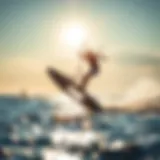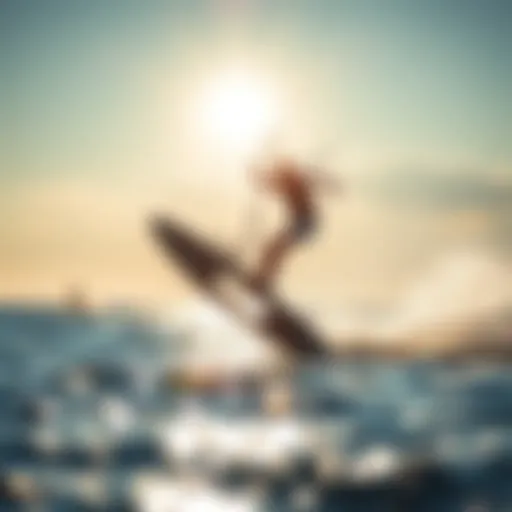Ultimate Mackite Foil Guide: Gear, Techniques & Performance
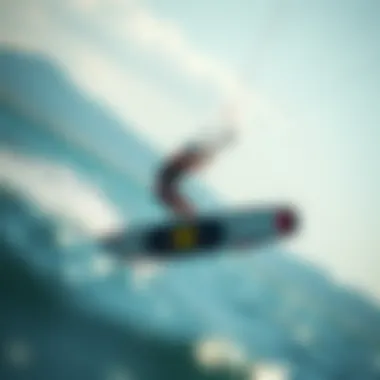

Intro
Mackite foiling has transformed the way enthusiasts engage with the water. It combines the thrill of kiteboarding with the smooth, graceful nature of foiling, offering a unique experience that attracts both beginners and seasoned pros. This sport opens up new dimensions in kiteboarding, enabling riders to glide effortlessly over the water's surface with minimal resistance.
Whether you're navigating through choppy waves or enjoying a flat, calm sea, understanding the intricacies of Mackite foils can significantly enhance your skills and pleasure on the water. This guide dives deep into the nuanced world of Mackite foils, discussing performance characteristics, essential techniques, and the right gear to maximize your experience.
Exploring Performance
Understanding the performance of Mackite foils is critical for making the right choices in gear and mastering techniques. Factors like wingspan, material properties, and weight distribution play a crucial role in how a foil behaves on the water.
Gear and Equipment
Mackite foiling cannot be accomplished without the right gear. Equip yourself properly to ensure safety, performance, and enjoyment.
Essential Kiteboarding Gear: A Comprehensive Guide
- Kite: The heart of your setup. Whether it’s the Naish Pivot or the Cabrinha Switchblade, each kite has unique attributes that cater to specific wind conditions.
- Board: A dedicated foil board, often shorter and wider, allows for better balance and lift during takeoff.
- Foil: The choice of the foil can create significant differences in performance. For instance, larger foils glide on lower winds, while smaller ones are more responsive in higher winds.
- Safety Gear: Always wear a helmet and impact vest to protect yourself during falls. Consider using a quick-release system on your harness for emergencies.
- Other Accessories: Don’t forget essential items like pumps, leashes, and repair kits.
Maintenance Tips for Kiteboarding Equipment
Proper maintenance extends the lifespan of your foiling gear, ensuring it performs well. Here are some tips:
- Rinse After Use: Saltwater can cause wear. Rinse your equipment thoroughly after each session.
- Inspect Regularly: Check for any signs of wear or damage, especially on your kite and lines before hitting the water.
- Store Properly: Roll kites and store them in a cool, dry place away from direct sunlight. This helps preserve the materials.
- Foil Care: Check the fuselage and wings for scratches or dings. Dented foils can greatly affect performance.
Techniques and Skills
Mastering Mackite foiling involves learning and refining specific techniques, allowing you to adapt to different conditions and improve your riding efficiency.
Beginner Techniques to Get Started with Kiteboarding
Starting off, focus on the fundamentals:
- Body Position: Maintain a low center of gravity and keep your knees bent.
- Controlling Speed: Use the kite to manage your speed. Flying it low will speed you up, while higher positions slow you down.
- Practice Balance: Spend time getting comfortable on your board in flat water before tackling waves or choppy conditions.
Advanced Maneuvers for Seasoned Kiteboarders
Once you’ve got the basics down, try these advanced moves:
- Transitions: Practice shifting your weight and changing directions smoothly.
- Jumping: Use the kite’s lift to propel yourself off the water, but remember to land with your knees bent for shock absorption.
- Waves Riding: Learning to ride swells can open up a whole new realm of excitement in your foiling journey.
"Kiteboarding is not just a sport; it's a vehicle for freedom and creativity."
As you develop your skills and understanding of Mackite foils, remember that every rider's path is unique. Connect with local groups or online communities to share experiences and tips. Platforms like Reddit offer great threads for beginners and experts alike.
In summary, Mackite foiling can truly elevate one’s adventures on the water. By grasping the gear needed and mastering essential techniques, anyone can enjoy the exhilaration that comes with this dynamic activity. As the sport continues to evolve, so does the potential for each rider to push their limits and explore new horizons.
Understanding Mackite Foil Technology
The world of Mackite foiling has grown by leaps and bounds in recent years, making it essential to grasp the underlying technology that powers this innovative watersport. Understanding Mackite foil technology proves invaluable for not just newcomers eager to ride the wind and waves but also for seasoned veterans looking to refine their performance. The nuances in design and functionality can dramatically influence how one interacts with the water and the broader environment.
Several elements are at play when discussing Mackite foils. The construction materials, wing shapes, and overall design choices can shape the rider's experience. With a proper comprehension of these aspects, one can optimize their setup to maximize performance while enhancing enjoyment and safety.
History and Evolution of Foiling
Foiling has its roots etched in surfing, but it has morphed into an entirely new discipline over time. Initially, the idea of elevating above the water created waves of skepticism. Early foils were clunky and cumbersome, often leading to frustration. However, advances in design techniques and materials enabled a shift toward more streamlined solutions.
What really set the stage was the emergence of kiteboarding in the early 2000s. As kiteboards evolved, so did the foils. Early adopters began crafting makeshift foils, testing their limits on lakes and oceans alike. This grassroots experimentation paved the way for companies like Mackite to revolutionize design and promote accessible, high-performance foiling.
Key Components of a Mackite Foil
Foil Wings
When it comes to foil wings, these components stand at the heart of any Mackite foil setup. They determine lift, speed, and maneuverability—critical factors for riders honing their skills. A key characteristic of Mackite's foil wings is their aerodynamic shape, designed for maximum efficiency. This feature allows for smoother rides with less drag, appealing to both novices and experts searching for a competitive edge.
However, choosing the right foil wing isn't without its challenges. Factors like surface area and aspect ratio can radically impact performance. Riders must consider their weight, skill level, and riding style when selecting wings. A larger, high-aspect ratio wing offers better lift for beginners, while a smaller wing appeals to advanced riders who prioritize agility over stability.
Masts
The masts play a crucial role in connecting the board to the wing, delivering stability and control while riding. Mackite's masts are typically constructed from lightweight yet durable materials, which is a big deal for riders who want to minimize fatigue. Their adjustable height makes them attractive for different riding styles, accommodating those who crave performance regardless of the conditions.
One unique feature of certain masts is their flexibility. While a stiffer mast offers immediate response and agility, a more flexible option can provide a smoother ride in choppy waters. The challenge lies in finding the right balance that suits each rider’s personal preference and experience level.
Fuselages
The fuselage serves as the integrating link between the mast and the wings, shaping how a foil interacts with the water. Mackite’s fuselages are engineered for simplicity and efficiency, with a modular design that allows for easy adjustments. A key characteristic of the fuselage is its stabilizing effect, which can enhance performance, especially in turbulent conditions.
A major benefit of Mackite’s fuselages is how they facilitate quick adaptations for ongoing performance enhancement. Riders can swap out wings and masts while maintaining structural integrity and performance. On the flip side, setting up a fuselage with incompatible components can result in difficulties, making a thorough understanding of each piece paramount.
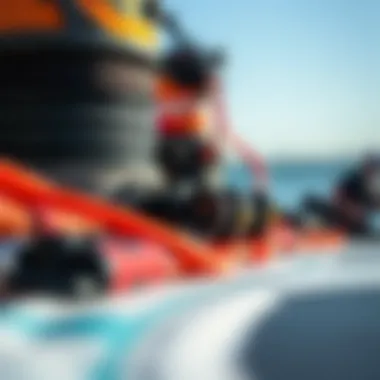

Boards
Finally, the boards are another pivotal aspect of Mackite foiling technology. These boards feature lightweight designs that add to flotation and maneuverability while reducing drag. Mackite’s boards have a unique shape and slick finish that allows a rider to glide smoothly through the water. The shape and size of the board also significantly affect how a rider generates speed and lift, echoing the importance of thoughtful selection based on personal requirements.
A distinguishing attribute of Mackite boards is their padded foot straps and ergonomic layouts, which provide comfort during longer sessions. However, a longer board may sacrifice maneuverability, whereas a shorter board can compromise stability—again highlighting the delicate balance involved in gear selection.
How Foil Design Affects Performance
The design of a Mackite foil isn't just functional; it's transformative. Each component—the wing profile, mast length, fuselage design, and board shape—affects how the foil interacts with water. The wrong choice can lead to disappointing experiences on the water. To get ahead, riders need to understand these design elements and what they bring to the table in terms of performance, safety, and durability.
In understanding Mackite foils, one grasp the pivotal role they play in shaping not just the mechanics of the sport but also the philosophy of enjoyment and connection to nature. As this technology evolves, recognizing its roots can give insight into future innovations and emerging trends within the foiling community.
Performance Analysis of Mackite Foils
When it comes to Mackite foiling, understanding performance is key for both novice and seasoned riders. The way a hydrofoil interacts with water, wind, and rider input can make or break a session on the water. Analyzing speed, stability, and maneuverability allows riders to optimize their experience, improve their skills, and select the right gear for their specific needs. This analysis not only enhances performance but also contributes to safety and enjoyment.
Speed and Stability in Various Conditions
Speed and stability go hand in hand in the world of Mackite foiling. The design of the foil plays a significant role in determining how fast one can go while maintaining a stable ride. A well-designed foil can slice through the water with minimal drag, allowing you to gain speed quickly. Different conditions present unique challenges. For example, in choppy waters, stability is crucial. A broader wing can provide more surface area to counteract the turbulence, allowing for smoother rides.
Factors to consider when assessing speed and stability include:
- Wing Shape: The design of the foil wings influences lift and drag. A high-aspect wing might excel in straight-line speed, while a low-aspect wing may offer better stability at lower speeds.
- Weight Distribution: Correct positioning can influence both speed and stability. Riders need to be aware of their stance and weight distribution to avoid losing control.
- Surface Conditions: Flat water vs. wave conditions require different approaches. A foil's performance can vary significantly based on these factors.
"The difference in ride quality can be stark. A stable foil promotes confidence as you push your limits."
Maneuverability and Control
Maneuverability is another vital aspect of Mackite foiling that can transform your riding experience. The ability to navigate turns, execute jumps, and respond quickly to changes in wind and water requires an intricate balance of foil design and rider technique.
Here are some key points that affect maneuverability:
- Fuselage Length: A shorter fuselage makes for quicker turns and a more agile response compared to a longer setup, which can provide stability for faster riding.
- Wing Configuration: Different wing shapes and sizes can enhance certain aspects of maneuverability. For instance, smaller wings may allow for sharp turns while larger wings may facilitate smoother shifts.
To optimize maneuverability, riders must practice and refine their control over the foil, learning when to shift weight and how much to lean into turns to avoid losing lift.
Impact of Wind Conditions on Riding Experience
Wind conditions are often the unseen force that can significantly alter the foiling experience. Understanding how wind affects your ride is crucial for maximizing performance. Light winds call for different equipment than heavy wind situations, affecting everything from kite size to foil selection.
In light winds, maintaining speed is typically more challenging, and a larger foil can be beneficial for generating lift. Conversely, in high winds, a smaller, more precise foil may offer better control, allowing for sharp maneuvers without getting overpowered.
Consider these elements when assessing the impact of wind:
- Wind Strength: Assess the wind conditions before heading out. Underestimating wind strength can lead to equipment failure or accidents.
- Directional Changes: Wind direction can impact how you plan your route. Knowing how to harness shifts in wind can enhance your performance tremendously.
Ultimately, the ability to read wind conditions and adjust gear accordingly is an essential skill for any Mackite foiler. Understanding the interplay between wind and performance can elevate your riding experience to new heights.
Techniques for Riding Mackite Foils
In the realm of Mackite foiling, mastery of techniques is pivotal. These skills not only enhance your performance but also elevate the entire riding experience. Knowing how to execute certain maneuvers can significantly impact your control over the board and foil. When you're out there gliding over waves or cutting through flat water, these techniques become the cornerstone of effective riding.
Grasping the various techniques allows riders to adapt to diverse conditions, making the experience enjoyable and challenging in equal measures. Furthermore, understanding these skills can keep you safe. A mishap in foiling can be serious; hence, learning the ropes of this thrilling sport doesn't just add finesse, but also ensures a safer outing.
Initiating Flight: Getting Off the Water
Transitioning from water to air is the first step in your Mackite foiling journey. To initiate flight, proper technique is crucial. The initial stance is paramount – keep your knees slightly bent, with your weight distributed evenly across the board. This balance is akin to setting the stage for a great performance; if the foundation is shaky, the rest can falter.
As you start to gather speed, gradually shift your weight back toward the tail of the board. This subtle shift allows the foil to generate lift. Timing is essential. Too soon and you'll risk crashing back into the water; too late and you may miss the perfect moment to ascend. Once you feel that delightful lift, stand tall, keeping your center of gravity directly over the foil. It's about finding that sweet spot between tension and relaxation.
"Every foiler has their own rhythm. Listen to your body, and allow the waves to guide your movements."
Mastering Turns and Jibes
Once airborne, the next hurdle is mastering turns and jibes. This aspect of foiling can be likened to learning to dance; it requires precision and grace to make it seamless. When preparing for a turn, begin by looking at your destination. This helps set the path. Lean into the turn, using your hips to guide your direction while maintaining pressure on the foot opposite to the turn.
To execute a jibe, shift your weight smoothly while adjusting the kite's angle. Keeping a steady tension on the line is necessary to avoid losing lift. Remember that turns in foiling aren’t just about steering; they demand a symphony of muscle, timing, and intuition. The journey to perfecting these maneuvers is part of the thrill.
Advanced Maneuvers: Tricks and Stunts
For those seasoned in Mackite foiling, advanced maneuvers open up a whole new world of excitement. Tricks elevate the sport from simple riding to a jaw-dropping performance. The essence of these stunts lies in their execution; focus is essential.
Jumping, for instance, requires a precise blend of power and timing. To launch, you must pop off the water by applying pressure on the board while simultaneously pulling on the handle of the kite. This motion lifts you into the air, where you then execute your trick. It's a dance of physics and practice.
A few popular tricks to consider include:
- Jumping – Going vertical with style.
- Spins – Twisting your body and board mid-air.
- Board-offs – A daring move where you let go of the board and bring it back before landing.
Practicing these stunts not only enhances your skills but also adds an element of flair to your rides, impressing friends and onlookers alike. Remember, the journey of mastering these techniques is enriching and requires patience and time.
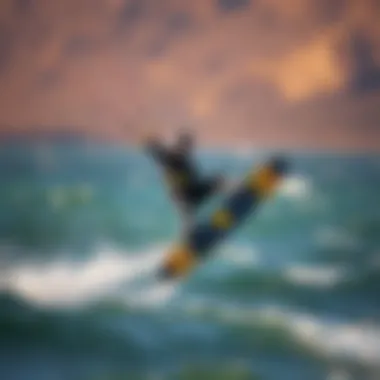

Gear Selection for Mackite Foiling
Choosing the correct gear is one of the most crucial steps in Mackite foiling. This selection process not only enhances your performance but also directly influences your safety and enjoyment on the water. When considering gear, it’s important to think of several factors, including skill level, the type of conditions you plan to ride in, and personal preferences. Each component plays a specific role in how your setup performs.
Choosing the Right Foil Size
Foil size matters more than one might think. Generally, the larger the foil, the more lift it provides at lower speeds, making it ideal for beginners or lighter winds. A larger foil may help you take off quicker, but can also have downsides such as reduced maneuverability. On the flip side, a smaller foil offers higher speeds and agility, appealing to more experienced riders.
When selecting foil size, consider:
- Your weight: Heavier riders may require a larger foil to achieve lift more easily.
- Wind conditions: Lighter winds benefit from larger foils, whereas in strong winds, smaller foils suit better.
- Skill level: As a newcomer, opt for a larger size to build confidence before transitioning to a smaller one.
Matching Kite Size to Foiling Conditions
Kite size is another key player in your Mackite setup. A properly sized kite ensures efficient power and control. The general rule of thumb is that a larger kite provides more power but can be challenging to manage, especially for those still finding their sea legs.
- Wind Speed: In lighter winds, a larger kite can help maintain consistent power; conversely, in strong winds, you might want to reduce your kite size to avoid being overpowered.
- Rider Skill and Weight: A heavier rider may find that they need a larger kite in most conditions, while lighter riders can often get away with smaller kites.
- Foiling Style: Consider if you plan to ride aggressively or focus on steady cruising. Your riding style can determine whether you need a responsive mid-size kite or a larger one for stability.
Board Selection for Optimal Performance
Choosing the right board is akin to finding the perfect dance partner; it's got to match your style and movements effortlessly. A board that's too big or too small can hinder your performance. Here are several crucial aspects to consider when selecting a board for Mackite foiling.
- Board Size: Larger boards provide more stability and easier takeoffs, while smaller boards deliver quicker response times and agility.
- Construction Material: Lightweight materials can enhance performance but might sacrifice durability. Bamboo boards are increasing in popularity for their strength-to-weight ratio.
- Rocker and Shape: A board's rocker can influence how easily you get on the foil. More rocker can facilitate takeoff but might require greater skill.
In summary, consider your unique needs and the factors involved in each gear component. The best approach is to take the time to experiment with different sizes and styles. It may very well mean the difference between a thrilling ride and an exhausting experience on the water.
"The right gear not only maximizes your performance but also amplifies the joy of riding. Make informed choices and enjoy the ride!"
For more detailed statistics on kite sizes and comparisons, you might find this resource useful: Kite Stability and Performance. Research helps a lot to make decisions that suit your foiling context.
Safety Considerations in Mackite Foiling
When engaging in any water sport, safety is paramount; Mackite foiling is no exception. Riders need to be aware of their surroundings, understand their gear, and maintain personal safety to enjoy the sport fully. Many novices often overlook safety measures, believing they can handle the risks easily. This mindset can lead to accidents that not only affect the individual but also those around them. By prioritizing safety, riders enhance not only their enjoyment but also their longevity in the sport, ensuring they can foil for years to come.
Essential Safety Gear
In the realm of Mackite foiling, having the right safety gear can make all the difference. While the thrill of gliding above water can be exhilarating, certain equipment acts as a lifeline in emergencies. Here’s a rundown of must-have safety gear:
- Personal Flotation Device (PFD): Always wear a US Coast Guard-approved life vest. It provides buoyancy in case of falls.
- Helmet: Head injuries can be severe, so a helmet designed for water sports can help protect against falls or collisions.
- Impact Vest: This added layer offers comfort and protection against the constant bumps and scrapes that can occur.
- Leash: Ensures that your board stays with you, preventing it from becoming a hazard to others if you fall.
- Cutting tool: Accidental tangles can happen, so having a knife or cutting device handy can be crucial.
Understanding Environmental Hazards
When foiling, one must respect and understand the environment. The following hazards are common but often overlooked:
- Currents: Local water currents can change with tides and weather. Understanding these can help avoid dangerous drifts.
- Wind Conditions: Sudden gusts or shifts can toss an inexperienced rider off balance. Always check wind conditions before setting out.
- Obstacles: Floating debris, rocks, and shallow areas can pose serious risks. It’s important to keep an eye out for these dangers while riding.
- Other Watercraft: Not everyone respects the same space on the water. Be aware of boats, jet skis, and swimmers.
Common Mistakes and How to Avoid Them
Even seasoned riders can make mistakes, and here are some of the common ones along with how to sidestep them:
- Neglecting Gear Inspection: Many riders skip checking their gear before hitting the waves, leading to equipment failures. Inspect your foil, kite, and other gear each time before use.
- Ignoring Local Regulations: Every location can have different rules regarding where and when you can foil. Familiarize yourself with local rules to enhance safety and avoid fines.
- Overestimating Skills: Riders often underestimate the challenges of conditions like strong winds or wave heights. Start slow and gradually push your limits as your skills develop.
- Forgetting Hydration: Out on the water, it’s easy to forget to stay hydrated. Always keep water on hand when preparing for a session.
"Safety isn't just about what you wear; it's about being aware and prepared for whatever nature throws at you."
By focusing on safety considerations, riders not only protect themselves but also cultivate a more enjoyable and supportive environment for newcomers in the community. With the right gear, knowledge of hazards, and mindfulness about common pitfalls, Mackite foilers can carve out a lasting experience on the water.
Maintenance and Care for Mackite Foils
Maintaining your Mackite foil is not just a mandatory task but a crucial aspect of ensuring longevity and performance. Foils are a significant investment, and taking the time to care for them can make a world of difference in their performance on the water. Let’s break down the essential components of maintenance that every rider should consider.
Cleaning and Storage Techniques
Keeping your foils clean is paramount. After each session, rinsing your foil, including the wings and the mast, with fresh water helps remove salt, sand, and dirt that can cause wear and tear. It's a simple act that can greatly extend the life of your gear. Here are some cleaning tips:
- Rinse Immediately: Don't wait until you get home. Rinse your equipment right after use. This makes a big difference in cleanliness.
- Soft Cloth or Sponge: Use a soft cloth or sponge for cleaning. Avoid abrasive materials; they can scratch or damage the surface.
- Dry Properly: Make sure everything is completely dry before storing it. Leaving moisture can lead to corrosion.
When it comes to storage, keep your equipment out of direct sunlight and in a cool environment. Utilizing a lockable hard case or foam bags can provide that extra layer of protection from the elements.
Routine Inspections and Repairs
Regular inspections are essential to catch any issues before they turn into costly repairs. Here’s what you should look for:
- Visual Checks: Inspect wings for cracks, dings, or any signs of delamination. Even little imperfections could lead to bigger problems.
- Hardware Inspection: Check all screws and connections to make sure they are tight. Loose components can lead to malfunction.
- Foil Flexibility: Make sure your foil has the right amount of flexibility. Too stiff or too wobbly can signal the need for a repair or replacement.
If you find any damages, take action immediately. Whether it’s applying a specific epoxy for small dings or seeking professional help, timely repairs can prevent accidents while riding.
Extending Lifespan of Your Foil
Extending the lifespan of your Mackite foil is not so complicated when you adopt a few habits. Here are some handy tips:
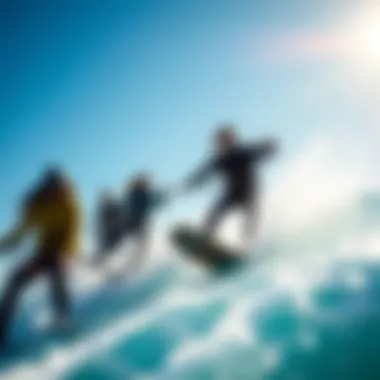

- Avoid Rugged Terrain: While it’s tempting to ride in challenging conditions, you should avoid rocky or wayward areas to keep your foil intact.
- Use Protection: Consider investing in protective covers or padding while transporting your foil to prevent scratches and dings.
- Rotate Boards and Foils: Switching up your gear can lessen wear on any individual piece, giving everything time to recover from use.
Taking good care of your foil and gear is simply as important as understanding the techniques and performance. A well-maintained foil means you can focus on what you enjoy—riding.
In summary, maintaining your Mackite foil involves cleaning, regular inspections, and thoughtful storage practices. Following these tips ensures that your foil not only performs at its best but also serves you well for years to come. Now that you know how to care for your foil, it's time to enjoy the thrill of Mackite foiling!
The Community Around Mackite Foiling
The thriving community surrounding Mackite foiling is an essential aspect of the sport, bringing riders together and fostering a sharing of ideas, techniques, and experiences. This connection not only enhances the enjoyment of the sport but also provides resources that can aid in skill development and safety awareness. By actively participating in the community, riders can tap into a wealth of knowledge that contributes to their growth and engagement with Mackite foiling. Being part of this environment shapes not just individual skills, but the overall culture of foiling itself.
Joining Local Foiling Groups
Finding a local foiling group is often the gateway to deeper involvement in Mackite foiling. These groups typically consist of a diverse set of individuals ranging from beginners to seasoned pros. Local groups provide several advantages:
- Networking: Meeting fellow enthusiasts opens doors to new friendships and riding partners.
- Shared Knowledge: Gaining insights from more experienced riders can accelerate your learning curve significantly.
- Camaraderie: Riding with others fosters a sense of belonging and support, which can be crucial when facing challenges.
Many local groups organize regular meet-ups at popular foiling spots, where members can share tips, gear recommendations, and their favorite tricks. Resources like Facebook Groups or Meetup.com can help you locate these local communities. Finding a group will not only make your riding sessions more enjoyable but can also ignite a passion for foiling that might just skyrocket your enthusiasm and skills.
Online Forums and Resources
In our increasingly digital age, online forums serve as an invaluable tool for Mackite foil riders. Websites such as Reddit, Kiteforum, and dedicated Facebook pages allow individuals to connect globally, exchanging ideas and experiences no matter where they are. These platforms often feature:
- Advice on Gear: Specific recommendations on which Mackite foils to choose based on varying skill levels and environmental conditions.
- Techniques and Tutorials: Riders share videos and detailed write-ups explaining their methods for tackling different maneuvers.
- Safety Discussions: Vital conversations about safety practices and hazard awareness that can be lifesaving.
Moreover, platforms like YouTube also host various channels dedicated to Mackite foiling, featuring gear reviews, instructional content, and even vlogs about riders' personal journeys in foiling. Utilizing these online resources helps riders stay up-to-date on the latest trends and news within the Mackite foiling community.
Events and Competitions in the World of Foiling
Participating in events and competitions is a fantastic way to immerse yourself in the Mackite foiling community. These gatherings foster a spirit of healthy competition while showcasing the skills of both amateur and professional riders. Attending—or even competing in—events brings multiple benefits:
- Exposure: Competing or watching can inspire new techniques and tricks, as riders showcase their unique styles.
- Community Building: Events often encourage social interactions, allowing riders to bond over shared interests and experiences.
- Learning Experience: Watching higher-level riders in action can provide insights into how to improve your own skills.
Look out for local, national, or even international competitions, as these often include clinics and workshops led by expert riders. Getting involved can enhance your skills while also solidifying your place within the larger foiling community.
"The strength of the Mackite foiling community lies not just in individual passion, but in the collective support and sharing of knowledge. Together, we grow stronger and more skilled against the waves!"
Ultimately, the community aspect of Mackite foiling enhances the overall experience. Whether through local groups, online discussions, or competitive events, riders can improve their skills, bond with others, and contribute to the culture that defines this exhilarating sport.
Exploring Popular Destinations for Mackite Foiling
When it comes to Mackite foiling, selecting the right destination can make all the difference. The locale doesn’t just impact performance; it shapes the overall riding experience. From closed, sheltered bays that provide calm waters for beginners to open oceans that challenge even seasoned experts, the right spot can help you level up your skills or just enjoy the ride. Whether you're on the hunt for a gentle introduction to the sport or thrill-seeking adrenaline rushes, making informed choices about where to foil plays a vital role in your success and enjoyment.
Best Locations for Beginners
First off, let’s dive into spots that are ideal for beginners. The key here is to find places that offer a mix of safety and manageable conditions. Some can be real gems for novices set on learning the ropes. Here are a few to consider:
- Lagoons: The flat water and consistent winds in lagoons, such as those found in Maui, make them perfect. These waters limit the risk of wipeouts and provide a soothing environment to practice.
- Shallow Beaches: Locations with sandy beaches like Kite Beach in Cabarete, Dominican Republic, offer shallow waters where newbies can stand and get their balance. Plus, the beach vibe is welcoming for first-timers.
- Protected Areas: Beaches that are shielded from strong currents and large waves, such as Lake Huron in Michigan, provide a safe gateway for those just starting out. Here, you can practice your tricks without the worry of immediate hazards.
In choosing these locations, be sure to keep an eye on weather conditions. The last thing you want is to head out when it's too windy, as that can lead to a rough experience for new riders.
Challenging Spots for Advanced Riders
On the flip side, advanced riders may be looking for that extra challenge. Experienced kiteboarders thrive on adrenaline, seeking out locations that test their skills under unpredictable conditions. Here are some thrilling spots for those with a bit of experience:
- Hookipa Beach, Hawaii: Known as a mecca for kiteboarders, its strong winds and larger waves cater to those ready to take their skills to new heights. It’s a site where you might also catch sight of pros showing off maneuvers that would impress even seasoned travelers.
- Punta de Mita, Mexico: This location offers powerful winds and challenging waves, perfect for capricious conditions that seasoned riders crave. Mastering turns and jumps against the backdrop of the tranquil ocean can elevate your skills significantly.
- The Gorge, Oregon: Wind and water conditions vary here, making it a playground for advanced foilers looking to push their limits. It’s not uncommon to find updrafts and crosswinds that add an extra layer of excitement.
When venturing out to these advanced spots, make sure to respect local regulations and other riders, ensuring an injury-free time.
For anyone looking to expand their experience while riding, knowing the lay of the land can enhance your skill set and enjoyment. Good fortune often favors the prepared!
With the right destination, your Mackite foiling journey can be rich and rewarding, whether you're just starting or are a seasoned rider seeking new adventures. So, pack your gear and get ready to explore these incredible locations!
Future Trends in Mackite Foiling
As Mackite foiling gains traction among both avid kiteboarding fans and newcomers, understanding the evolving landscape of this sport is critical for anyone looking to stay ahead of the curve. The popularization of foiling has led to several trends that are shaping the future of this exhilarating pastime. From innovative gear enhancements to shifting community dynamics, recognizing these developments is vital to unfolding the full potential of Mackite foiling.
Technological Innovations on the Horizon
The pace of technological progress in the foil industry is akin to a wildfire catching wind. We've seen a slew of advancements over the past few years that have redefined the riding experience. Manufacturers are increasingly prioritizing lightweight materials, such as carbon fiber and advanced composites, which significantly enhance performance while ensuring durability.
Key Innovations
- Smart Foiling Gear: Imagine foils equipped with sensors that track your speed, height, and stability. These advancements could provide real-time feedback, allowing riders to adjust their techniques instantly.
- Adjustable Wings: New designs featuring adjustable wings allow riders to customize their setups based on wind conditions and personal riding style. This flexibility can drastically improve performance across various environments.
- Hydrodynamic Improvements: Enhanced wing designs focus on reducing drag and increasing lift. Such refinements not only boost speed but also improve maneuverability, giving every rider the chance to push their limits.
The rise of sustainable practices within manufacturing also bodes well for future trends. Environmental concerns are prompting brands to explore eco-friendly materials and production methods, integrating sustainability into the sport without compromising quality. Keeping an eye on these innovations makes it easier to adapt and elevate your riding.
Changing Dynamics of the Kiteboarding Community
As more people pick up the sport, the kiteboarding community is transforming into a vibrant hub of collaboration and learning. The influx of new riders and technological enthusiasts brings fresh perspectives and ideas. Local foiling groups are sprouting up, providing informal settings for skill-sharing and socializing. This shift enhances camaraderie and promotes a culture of mutual growth, diminishing the old barriers that sometimes had riders feeling isolated.
Notable Trends
- Increased Inclusivity: Organizations and clubs are striving to create accessible programs to engage a broader range of ages and skill levels. This change enhances participation, leading to a more diverse set of voices in the sport.
- From Competitions to Community Events: While competitions remain a highlight, there's a growing emphasis on community events that celebrate all aspects of foiling. These gatherings offer opportunities to test gear, learn new techniques, and form friendships.
- Online Spaces: Digital platforms are evolving into resource goldmines for enthusiasts. Online forums and social media groups nurture discussions, enabling riders to share their experiences and seek advice. Sharing knowledge in this connected world accelerates personal growth and expands one’s understanding of the sport.
As the Mackite foiling community continues to grow, embracing these changes will be crucial. From technological innovations to inclusive practices, each trend has the capacity to elevate the sport, making it enjoyable and accessible for everyone. Keeping pace with emerging developments ensures you remain a part of this ever-evolving narrative.




